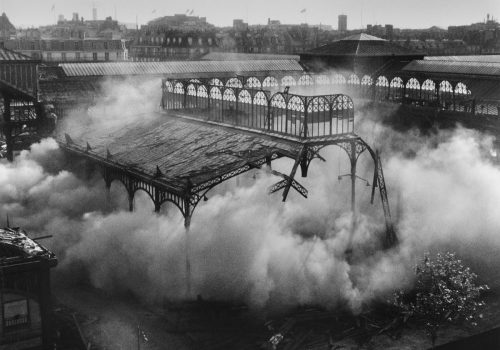From January 18 to March 3, 2018, Galerie Argentic in Paris presents a selection of about fifty photographs by Jean-Claude Gautrand, French photography’s privileged witness. This selection covers over 60 years of work and brings together his most beautiful series, including Métalopolis and Le Galet, featured here.
The appeal of discovering traces of the past is undeniable. The silence of ruins is quite often like a memory machine. Facing the degradation and gradual dissolution of certain places stirs a wave of permanent emotion. It calls for the need to recover, and preserve, entirely or in part, our roots . The collection of Jean-Claude Gautrand’s images thus responds to a real need that only photography may satisfy. It answers the wish expressed by Charles Baudelaire: “Let it save from oblivion these crumbling ruins … which time is devouring, all those precious vowed to dissolution, which demand a place in the archives of our memory…,”[1] the archives indispensable to understanding the present.
L’Assassinat de Baltard (1971)
Current events determined the direction Jean-Claude Gautrand’s work took next. In 1971, the photographer’s destiny crossed that of Baltard’s Les Halles in Paris, and he went on to chronicle what was about to disappear. The demolition of Baltard’s Les Halles that year spelled a truly radical change for the residents of Paris. Like them, Gautrand reacted violently to this decision and protested against the destruction of this gem of 19th-century iron architecture located right in the heart of Paris. In the month of August, when the city was deserted by vacationing Parisians, Gautrand was one of the few to document the unfolding operation. He produced a sizeable pamphlet and an unflinching visual testimony that resonates, through expressionistic images, with the echo of a silenced neighborhood. “A calm balance between volume and line, on the one hand, and, albeit hidden, concern, indignation, and even rage. These feelings do not disturb the harmony of forms, but imbue the space with sometimes menacing poetry,” explains Jean-Claude Lemagny, a curator specializing in contemporary photography.
Bercy, la dernière balade (1979–1989)
A few years later the same issues would incite the photographer to compile the ultimate inventory of what was the last authentic 19th-century Parisian village. Sacrificed to profitable real-estate deals, Bercy had forever lost the charm, the tranquility, and the poetry of the labyrinthine streets and alleys it used to offer Parisians. This last stroll among wineries, cooperages, and streets is a poetic invitation to a “contemplative delectation” of a harmonious entanglement of plants and minerals. A location relatively little known by Parisians at the time, Bercy reveals in these photographs the extraordinary light that flooded this timeless village. One could call this series bucolic, and yet it does not hide the melancholic rage of a Parisian witnessing the destruction of his heritage.
Jean-Claude Gautrand, Itinéraire d’un photographe
January 18 to March 3, 2018
Galerie Argentic
43 Rue Daubenton
75005 Paris
France
www.argentic.fr
[1] Charles Baudelaire, “The Salon of 1859,” in Selected Writings on Art and Literature, trans. P.E. Charvet (London: Penguin Classics, 2006), p. 297. Translation slightly amended. The poet adds, right after this sentence, “in all these things, photography will deserve our thanks and applause.” —Translator’s note.
















